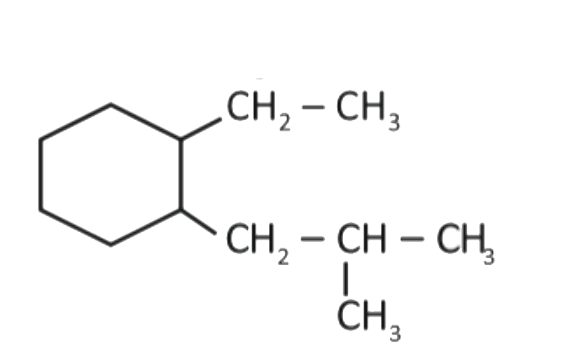The number of primary alkanols, secondary alkanols and tertiary alkanols possible with the formula C4H10O is given by the set :-
2,1,0
1,2,1
2,1,1
2,1,2
The correct Answer is:C
To determine the number of primary, secondary, and tertiary alkanols possible with the formula C4H10O, we will analyze the structures of the alcohols based on their classifications.
1. Identify the General Structure of Alkanols:
- Alkanols (or alcohols) have the general formula CnH2n+1OH. For C4H10O, we can have various structural isomers.
2. Determine Primary Alkanols:
- A primary (1°) alcohol is one where the hydroxyl group (-OH) is attached to a carbon atom that is connected to only one other carbon atom.
- Possible structures:
- Butan-1-ol: CH3CH2CH2CH2OH (the -OH is on the terminal carbon).
- 2-Methylpropan-1-ol: CH3CH(CH3)CH2OH (the -OH is on the terminal carbon of a branched structure).
- Total primary alkanols = 2.
3. Determine Secondary Alkanols:
- A secondary (2°) alcohol is one where the -OH group is attached to a carbon atom that is connected to two other carbon atoms.
- Possible structure:
- Butan-2-ol: CH3CH(OH)CH2CH3 (the -OH is on the second carbon).
- Total secondary alkanols = 1.
4. Determine Tertiary Alkanols:
- A tertiary (3°) alcohol is one where the -OH group is attached to a carbon atom that is connected to three other carbon atoms.
- Possible structure:
- 2-Methylpropan-2-ol: C(CH3)3OH (the -OH is on the central carbon of a branched structure).
- Total tertiary alkanols = 1.
5. Summarize the Findings:
- Primary alkanols: 2
- Secondary alkanols: 1
- Tertiary alkanols: 1
6. Final Set Representation:
- The number of primary, secondary, and tertiary alkanols can be represented as the set {2, 1, 1}.
Conclusion:
The answer to the question is the set {2, 1, 1}.
- Alkanols (or alcohols) have the general formula CnH2n+1OH. For C4H10O, we can have various structural isomers.
- A primary (1°) alcohol is one where the hydroxyl group (-OH) is attached to a carbon atom that is connected to only one other carbon atom.
- Possible structures:
- Butan-1-ol: CH3CH2CH2CH2OH (the -OH is on the terminal carbon).
- 2-Methylpropan-1-ol: CH3CH(CH3)CH2OH (the -OH is on the terminal carbon of a branched structure).
- Total primary alkanols = 2.
- A secondary (2°) alcohol is one where the -OH group is attached to a carbon atom that is connected to two other carbon atoms.
- Possible structure:
- Butan-2-ol: CH3CH(OH)CH2CH3 (the -OH is on the second carbon).
- Total secondary alkanols = 1.
- A tertiary (3°) alcohol is one where the -OH group is attached to a carbon atom that is connected to three other carbon atoms.
- Possible structure:
- 2-Methylpropan-2-ol: C(CH3)3OH (the -OH is on the central carbon of a branched structure).
- Total tertiary alkanols = 1.
- Primary alkanols: 2
- Secondary alkanols: 1
- Tertiary alkanols: 1
- The number of primary, secondary, and tertiary alkanols can be represented as the set {2, 1, 1}.
The answer to the question is the set {2, 1, 1}.
Topper's Solved these Questions
- IUPAC NOMENCLATUREBOOK - ALLENCHAPTER - IUPAC NOMENCLATUREEXERCISE - Exercise - 03
3 Videos
- IUPAC NOMENCLATUREBOOK - ALLENCHAPTER - IUPAC NOMENCLATUREEXERCISE - Exercise - 04
4 Videos
- IUPAC NOMENCLATUREBOOK - ALLENCHAPTER - IUPAC NOMENCLATUREEXERCISE - Exercise - 01
20 Videos
- ATOMIC STRUCTUREBOOK - ALLENCHAPTER - ATOMIC STRUCTUREEXERCISE - Exercise - 05[A]
14 Videos
- MOLE CONCEPTBOOK - ALLENCHAPTER - MOLE CONCEPTEXERCISE - Exercise - 05(B)
8 Videos
Similar Questions
Knowledge Check
How many alkenes are possible with molecular formula C4H8 :
A2B3C4D6
Molecular formula C4H10O represent
View SolutionHow many cyclic alcohols are possible with molecular formula C4H8O ?
View SolutionThe number of metamers possible for C4H10O is
View SolutionThe number of primary, secondary and tertiary carbons in the following, structure are respectively

View SolutionThe number of isomeric amines possible for the formula C3H9N
View SolutionThe number of possible primary alcohols with the molecular C4H10O is:
View SolutionHow many isomeric alcohols with formula C4H10O are possible ?
View Solution
